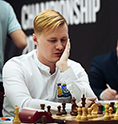8 June 2014
At the brewery
Grandmaster Vasily Yemelin analyzes the gems of the first three rounds of the Chess Olympiad in Tromso.
Despite the rather "unorthodox" approach of the organizers to their duties and signed documents, chess fest at the Norwegian brewery can be considered valid. For all that, World Chess Olympiad started. All points of the rules were eventually read and one third of a distance has already passed. Below is the review of the first three rounds of the event.As a general rule in the starting rounds of any Swiss system competition the difference in opponents’ ratings makes spectators follow only huge upsets, blunders and favorites’ failures. The start of the tournament is a warm-up for some and a circus for other; and even for a stumbled grandmaster it is often an annoying but easily remedied unpleasantness. I start my review in this vein.
We cannot speak about tightly contested matches in the first round as most of them ended with perfect scores. However, in the individual games there were some adventures...
Fans of Sergei Movsesians’ creations won’t be surprised by the happy outcome of the following game, which logically reached the position at the diagram.
S. Kojima – S. Movsesian
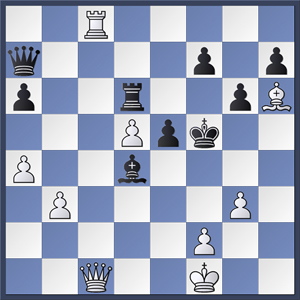
The quickest mate comes after 33.g4+ Ke4 (33...Kxg4 34.Qg5+ Kf3 35.Qg2#), but here one should find not the most trivial 34.Ke2. However, White is in a time trouble for the last 10 moves.
33.f3
Simple and elegant, like a blow of an ax on the forehead.
33...Rxd5
It remains only to immobilize the victim (34.Rc6, 34.Re8), and mate is inevitable. Yet, at the end of the day Black even won.
Draw was like a godsend for the clear favorites in the following two examples.
A. Al Badani – J. L. Hammer
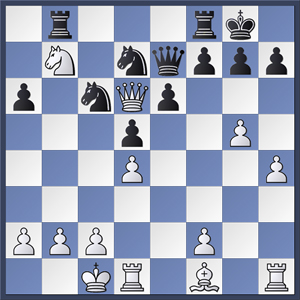
For some reason Black imposed a pawn sacrifice on the opponent and encountered problems when he just captured it. He has to count on catching a knight.
18...Qxd6 19.Nxd6 Rb6 20.c4 Nb4
Nothing good is promised by 20...Rfb8 21.b3 Nxd4.
21.a3!?
White is ambitious and vindictive: «You captured my horsy, I will catch yours!» Simple 21.c5 Nxa2+ 22.Kc2 Nb4+ 23.Kb1 Rc6 24.f4 with Rh1–h3 was probably stronger. Black’s position is bad.
21...Na2+ 22.Kc2 Rfb8 23.b4 Rxd6 24.c5 Rc6 25.Kb3 Nxb4 26.axb4 e5 27.Bh3 Nf8 28.Kc3
Perhaps White vainly succumbed to the beauty of mutual knight catching. After 28...Ne6! 29.Bxe6 fxe6, he only has a slight edge in the rook ending. However, Black continues to tempt his fate:
28...exd4+? 29.Kxd4 Ne6+ 30.Kxd5 Rcc8
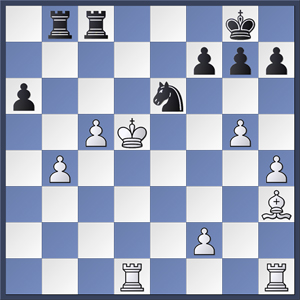
It is only left to play 31.Bxe6 fxe6+ 32.Kc4 Rf8 33.c6 and (accompanied with whistling and hooting) inflict a humiliating defeat on a 450-points-ahead opponent, a second of “you know who”, but...
31.Kc4? a5, and Black saved the day with a draw.
B. Lyti – P. Negi
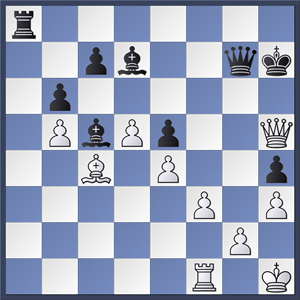
Black’s optimism in this game amazes. Instead of 40...Qh6 with a perpetual check, Black boldly sweeps upon discovered checks:
40...Kf8?? 41.d6+ Kf8 42.f4 cxd6 43.fxe5+ Ke7 44.Rf7+??
If we believe the broadcast, White made this impulsive move very quickly and did not use the time that was added after the 40th move. After 44.Qxh4+ Ke8 45.Bf7+ Qxf7 46.Qh8+ all that is left for Black is to resign.
44...Kd8
Here after capturing the queen White has an advantage too (Black regains the queen with a series of checks), but it is all not quite the same. Draw.
In principle, a win over a huge underdog of course requires a certain "lack of respect" for his chess abilities, but... the following game is a fine illustration of drawbacks to such an attitude:
Al-Hadarani – K. Lie
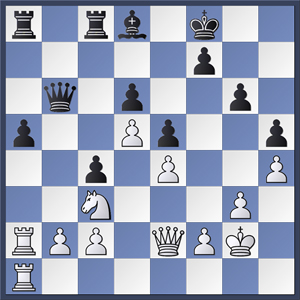
Black's position is quite unenviable.
24.Rh1 Bf6 25.Rha1 Kg7 26.Nd1 Rc5 27.Nc3 Qb7 28.Nd1 Bd8
How to explain that White repeats the moves? I will allow myself to an assumption that White was ok with a draw. And Black... is not?!
29.Ne3 Rac8 30.g4 Bxh4
30...Qe7 could allow to somehow hold. Now losing is inevitable.
31.gxh5 Rh8 32.hxg6 fxg6 33.Qg4 Be7 34.Rxa5 Rc7 35.Nf5+ Kf7 36.Nxd6+ Bxd6 37.Qe6+ Kg7 38.Qxd6 Qc8 39.Qxe5+ Kf7 40.Qf4+ Kg7 41.Qxc7+. Black resigns.
The games of our teams saw no adventures. Nepomniachtchi pleased the crowd with a creative show.
I. Nepomniachtchi – F. Mohannad
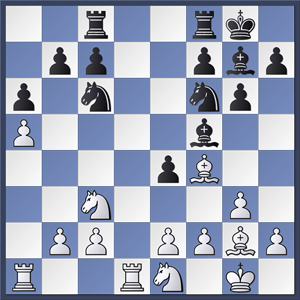
Clearly, White has not achieved the due in the opening. It even seems that Black has an edge. Ian manages to implement a completely classical idea – improving the position of the "worst" piece – in a way that is rarely seen in the practical game.
14.h3
The immediate 14.Bh1 was possible, but then Nf6-h5 is strong in some lines.
14...h5 15.Kh2 Rfe8 16.Bh1 Bf8?!
Black is vainly distracted by a pawn; White’s positional dividends appear higher than a pawn. It was necessary to use some prophylactic with 16...Nb4.
17.Ng2 Bb4 18.Ne3 Bxa5 19.Ncd5 Kg7 20.Nxf6 Kxf6 21.g4 hxg4 22.hxg4 Be6 23.g5+ Kg7 24.Bxe4 Bb6 25.Bxc6 bxc6 26.Kg3 f6 27.Rxa6 fxg5 28.Bxg5 Rh8 29.Ng4 Rcf8 30.f3 Rh5
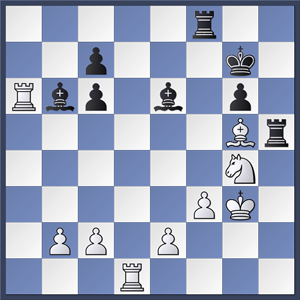
The diagram shows the logical consequence of White’s adventurous play. After 31.Bd2 Black feels bad. However, if we believe the broadcast, after 6 seconds White played
31.Be7? Re8 32.Bf6+ Kf7 33.Ra3?
One more mistake, though after 33.e4 Bxg4 34.fxg4 Rb5 or 34...Rc5, Black already has fair chances for a draw.
33...Bc5 34.Ra6 Bxg4?!
After the tempting 34...Bd6+ 35.Rxd6 cxd6 36.Ra7+ Kg8, the position is unclear.
35.fxg4 Re3+?!
Better is 35...Rd5, and Black is close to a draw.
36.Kf4 Rh2 37.Rxc6 Rf2+ 38.Kg5 Bd6 39.Rdxd6 cxd6 40.Rc7+ Kf8 41.Bd4 Rexe2 42.Bxf2 Rxf2 43.Kxg6 Rg2 44.g5 Rf2 45.b4 d5 46.b5 Rf4 47.b6 Rb4 48.b7 Black resigns.
Is it a coincidence that the opponent did not give a check that suggesting itself? Of course not. After all, Ian pulled the team in the World Team Championship in Antalya in the same way, scoring points in positions that were not conductive to it. Only a complete noob in RPG would not distinguish luck from strong witchcraft. I put forward a theory that Ian purposely did not immediately finish the enemy hero with units, and used the opportunity to pump up a hypnotic skill. I would suggest that this unique skill was the reason why a wise head coach preferred Ian to a couple of other available heroes who at the moment have a somewhat better experience and damage level.
It has not yet come to the meetings of "heavyweights" in the second round, and it was too early to look for imperishable masterpieces of positional play. However, there were a few interesting and eventful games played.
T. Nyback – M. Carlsen
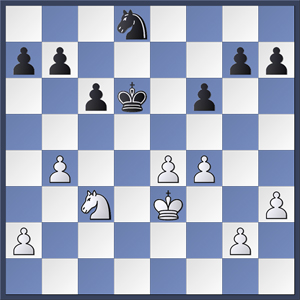
White has a symbolic plus due to space advantage. Magnus demonstrates a powerful solution to problems before they even appear.
26... a6!, threatening c6-c5.
There were alternative ways too, for instance 26...b5!? with the idea a6 and c5, which White cannot prevent, or 26...b6 with similar ideas.
27.Na4 Ne6 28.f5 Nd8 29.Kd4 Nf7 30.Nc5 b6
That's the point. Black sacrifices a pawn, and White’s knight is trapped.
31.Nxa6 Ne5 32.a4 Nd7 33.Kc4 Ne5+ 34.Kd4 Nd7 35.Kc4 Ne5+ 36.Kd4 Draw.
D. Smerdon – L. Aronian
1.e4 d6 2.d4 Nf6 3.Nc3 Nbd7 4.f4 e5 5.fxe5 dxe5 6.dxe5 Nxe5 7.Qxd8+ Kxd8 8.Bg5 c6 9.0–0–0+ Kc7 10.Nf3 Bd6 11.Be2 Nxf3 12.gxf3 Nh5
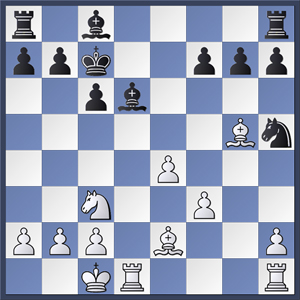
13.Rxd6!
Apparently, the sacrifice is sound and is the most logical continuation. Yet it is a very courageous decision, given Levon’s mastery of playing with material imbalances.
13...Kxd6 14.Rd1+ Kc7 15.Be7 b6 16.f4 g6 17.b4 a6
The b-pawn indeed aimed to move further, what is demonstrated by the line 17...Re8 18.Bd6+ Kb7 19.b5 Bd7 20.Be5 with the initiative for White.
18.a4 Kb7 19.Bxh5 gxh5 20.f5 Re8 21.Bf6
White has a full compensation for an exchange. Black’s bishop is limited by the “Lasker” wedge on f5, pieces are uncoordinated, pawns are weak. Perhaps, White should have started with destruction of the kingside, and with this purpose more accurate is 21.Bh4! with the idea Rd1-d6. Focusing on the queenside gives Black an opportunity to activate his pieces.
21...Ra7 22.a5
22.Rg1 looks good.
22...bxa5 23.bxa5 Kb8 24.Rd6?!
Here 24.Rg1 c5 25.Rg7 Bb7 26.e5 Bc6 27.Rxh7 Rg8 28.Rxh5 Rg1+ 29.Kd2 Rd7+ 30.Ke3 with an unclear game is definitely better. White got the material back, Black’s initiative is sufficient for an equality, but no more. Computer, as usual, shows zeros.
24...Rd7 25.Rxc6 Bb7 26.Rb6 Ka8
An attack on the a5-pawn looks strong, after 26...Rc7 follows Rc5.
27.Rb4 Rc7 28.Nd5 Bxd5 29.exd5 Rec8 30.c3 Rd7 31.Rb6 Rxd5 32.Rxa6+ Kb7 33.Rb6+ Ka7 34.Kc2 Rxa5 35.Bd4 Ka8 36.Rf6 Rc7 37.Kd3 Re7 38.h4 Kb7 39.Kc4 Rc7+ 40.Kd3 Re7 41.Kc4
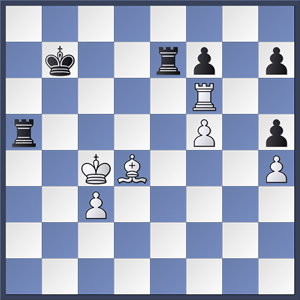
In the preceding game with mutual inaccuracies Black managed to make progress, and now he has good chances to convert an exchange. I believe that after a trade of rooks (which is often recommended in the positions with an extra exchange) White does not manage to build a fortress, and Black should gradually win. An exemplary line showing the winning plan: 41... Ra6 42.Rxa6 Kxa6 43.Kd5 Kb7 44.Be5 Kc8 45.Bf6 Re2 46.Kd6 Rf2 47.Ke5 Kd7 48.c4 Kc6 49.Bg5 Rf1 50.Be7 Re1 + 51. Kf6 Kd7 52.Ba3 Re4 53.Kg5 Rxc4 54.Kxh5 f6, and this position should be technically won.
The game continued with three rooks on the board, and White was able to hold...
A. Guerrero Vargas – J. Polgar
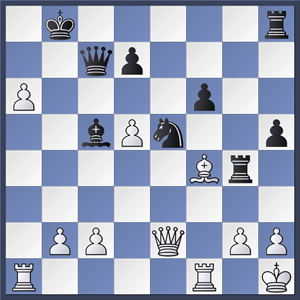
As a result of an extremely aggressive play of both sides a double-edged position has arisen, in which White’s chances are slightly better. The g4-rook works both vertically and horizontally, so it would be useful to play 26.h3!? Immediate rook capture is not a threat, but could become one in some case (like in the game). Unclear is 26.b4 Ba7 27.c4 Rhg8 with a sharp game. Alas, White chooses an inaccurate order of moves:
26.Rf3 Ka8 27.h3 Rhg8?
Black loses an excellent opportunity not only to strengthen his position, but also to get rid of the knight pin by 27 ... d6! In the same time he misses a blow in the center.
28.d6! Qc6?
This should lead to a loss. After the primitive capture 28...Qxd6 29.Qe4+ Qc6 30.Qxc6+ Nxc6 31.hxg4 hxg4 32.Rc3 Rh8+ 33.Bh2 Bd4 (it is important to disturb the rook on this square) 34.Rd3 Bf2 Black keeps excellent chances for a draw.
29.hxg4! hxg4 30.Rc3 Rh8+ 31.Bh2 Qxd6 32.Qe4+ Nc6
And suddenly White slips one step before his triumph.
33.g3??
It was necessary to find the only move 33.Rh3! just by an exclusion method, then go home happy and satisfied with a win over Judit Polgar herself!
33...Rxh2+ 34.Kxh2 Qd2+ White resigns.
A funny trick that is not typical for rook endgames happened in the next game.
P. Kotsur – N. Grandelius
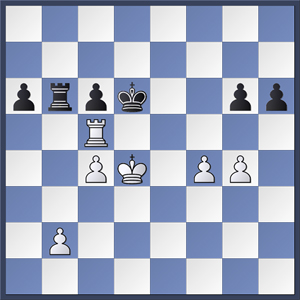
38.Rd5+
It is the right idea in an inaccurate implementation. 38.Rh5! c5 + 39.Rxc5 Rxb2 40.Ra5 left White with an extra pawn and excellent winning chances. However, the move in the game also creates serious problems for Black.
38...Kc7
Capturing is impossible, for the pawn endgame is lost: 38...cxd5? 39.c5+ Kc6 40.cxb6 Kxb6 41.Kxd5 h5 42.gxh5 gxh5 43.Ke4 Kc5 44.Kf5 Kd4 45.Kg5 Ke4 46.f5, and after mutual queening White wins a queen with a check on the long diagonal.
39.Re5 Rxb2 40.Re7+ Kd6 41.Rg7 c5+
Unclear are the consequences of 41...Rd2+ 42.Ke3 Rg2 43.Kf3 Rh2 44.Rxg6+ Kc5 45.f5. First of all it is worth checking if Black could escape with the most natural moves.
42.Ke4 g5 43.Rg6+ Ke7 44.fxg5 hxg5 45.Kd5
45.Rxg5 Rg2 46.Kd5 transposed to the same position.
45...Rg2 46.Rxg5 a5 47.Kxc5 Kf6?
This is the exact moment when Black missed a draw. Correct is 47...a4 48.Kb4 Kf6 49.Rc5 (49.Rg8 Kf7 50.Ra8 Rxg4 51.Rxa4 Ke7 52.Kb5 Kd7=) 49...Rxg4 50.Kxa4 Ke6 51.Kb5. Draw in this position is achieved in an instructive way: 51...Rg8 52.Kc6 Rc8+ 53.Kb6 Rb8+ 54.Kc7 Rb4! (one should memorize this position of a mutual zugzwang) 55.Kc6 Rb8 56.Kc7 Rb4 57.Rc6+ Ke5=.
48.Rf5+ Ke6 49.Rf4 Ke5 50.Rf1 Rxg4
Or 50...Ke6 51.Kc6.
51.Re1+ Kf6 52.Kb5 a4 53.Re3, and White wins thanks to the cut off king of the opponent.
There was no intrigue in the match of our men’s team, but it could be not so rosy.
S. Karjakin – A. Nezad Husein
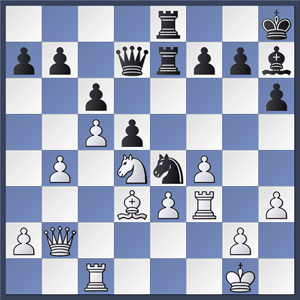
White conducted the opening not so great and his position is worse. With his last move (26...Qd7) Black covered the f5-square in the event of bishops exchange after the scheduled Ne4-f6. Instead of playing for retention, Karjakin sticks to the intended logical line, regardless of the material.
27.b5!? Nf6 28.f5 Rxe3 29.Rxe3 Rxe3 30.bxc6 bxc6 31.Qb8+ Bg8 32.Bf1 Re4
The position is probably too complex for this cursory review. 32...a5!? is perhaps the strongest. In some lines the pawn is not under attack. The variations 33.Qd6 Qb7 34.Nxc6 Qb2 35.Rd1 Qc2 36.Qf4 Qxc5 and 33.Rd1 Qe7 34.Qd6 Qe4 35.Nxc6 Qxf5 36.Nd4 Qg5 illustrate an essential thing for understanding the situation: dark squares are so weak that in some lines Black causes serious damage even without his helpless bishop. However, after, for example 33.Ba6 a4 34.Kh1!? (but not 34.Nxc6 Qxf5! or 34.Qd6 Qa7) he still has to look for the clear path.
33.Rd1 h5?!
This is a serious inaccuracy. It was necessary to cover the d6-square by 33...Ne8!, and Black fights for advantage, planning to cause white queen’s retreat after Qe7. Trying to attack c6 pawn for instance with the bishop is not justified: 34.Qb2 Qc7 35.Bd3 Re3 36.Qc1 Re7 37.Bc2 Nf6 38.Ba4 Qg3 39.Bxc6 Re3 with the advantage for Black.
34.Qd6 Qb7 35.Qxc6 Qb2?
In fact, a crucial mistake in a roughly equal position. The correct 35...Qb4 36.Nf3 (or 36.Nb3 Re1) 36...Qc3 37.Qd6 Qe3+ 38.Kh2 Ra4 keeps the game balanced due to the weakness of white king.
36.Qa4, and White gradually converted his advantage.
H. Al-Tamimi – I. Nepomniachtchi
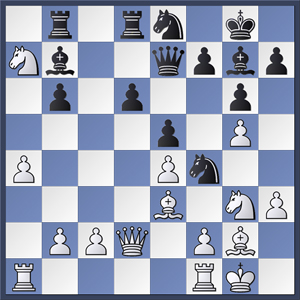
Given the weakness of the White's kingside and the inevitable breakthrough in the center with d6-d5, it seems that Black's counterplay for the pawn is very dangerous. In reality, things are not so scary. Now White could destroy the active knight: 19.Bxf4 exf4 20.Qxf4 Ra8 21.Nb5 Bxb2 with an unclear position, but unexpectedly demonstrated outstanding positional understanding, preferring to return the material, but avoid the activation of the King’s Indian bishop.
19.h4!? Nxg2
Another pawn sacrifice makes the computer happy: 19...d5 20.Bxb6 Rd7 21.Rfd1 d4, but it’s not immediately clear why.
20.Kxg2 Ba8 21.Nb5 d5
It could seem that Black’s Sicilian dream came true. Unfortunately for him, White does not need to respond.
22.Qe2 dxe4
22...Nc7 23.Nxc7 Qxc7 24.Rfc1 does not improve the situation. Now White easily neutralizes possible threats of Black by simplifications.
23.Rfd1 f5 24.gxf6 Nxf6 25.Rxd8+ Rxd8 26.Rd1 (26.Nc3!?) 26...Nd5 27.Nc3 Nf4+
27...Nxe3+ 28.fxe3 h5 gives nothing (if 28...Qxh4 29.Qc4+ Kh8 30.Rxd8+ Qxd8, then 31.Qe6 with unclear consequences) 29.Qa6 with a sufficient game for White. The knight went to d5 not for just capturing the bishop...
28.Bxf4 exf4 29.Rxd8+ Qxd8 30.Qc4+ Kf8 31.Ngxe4 Bxc3 32.bxc3 Kg7 33.f3 Bxe4
33...Qxh4 changes nothing: 34.Qd4+ Kh6 35.Qe5.
34.Qxe4 Qxh4 35.c4, and White confidently held in the queen endgame.
This game is amazing in its own way: with the rating difference of six hundred points, the favorite failed to outplay his opponent in a complex position without making obvious mistakes. Modern chess, what can you do.
The first match sensation was the draw of one of the teams competing for victory – the Ukrainian squad. Inexplicable glitch in Ivanchuk’s play was compensated with only one win.
F. Urkedal – V. Ivanchuk
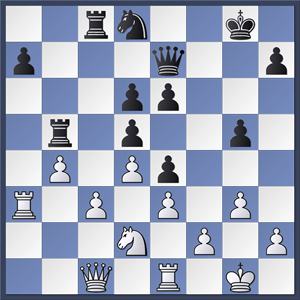
To make sure that this game was attended by a wrong version of Ivanchuk, it is enough to see the next Black’s move in this already quite unpleasant position.
23...Rxb4? 24.cxb4 Rxc1 25.Rxc1 Qb7 26.Rac3, and in a couple of moves the knight was lost.
26...Nf7 27.Rc8+ Kg7 28.R1c7 Qxb4 29.Nf1 Black resigns.
Amazingly, two misfires also happened in the match of Ukrainian women’s team, but they did not lead to serious consequences.
A. Muzychuk – I. Berezina
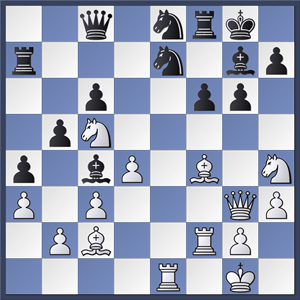
So far everything is logical: White strongly presses and Black fails to stand it.
28...g5? (28...Rf7 would not lose on the spot), and now after 29.Bb8! gxh4 30.Qxh4 Qxb8 31.Bxh7+ everything should have ended, However, White misses the target.
29.Bxg5?! fxg5 30.Rxf8+ Kxf8 31.Qxg5 Nf6 32.Bf5 Nxf5 33.Nxf5 Qc7 34.Re3
White did not lose the winning chances, but it’s not trivial anymore. For winning she had to sense that after 34.Ne6+! Bxe6 35.Rxe6 Ne8 36.Re3! the decisive domination is on White’s side despite being short of a piece on a half-empty board. For instance, 36...Qf7 (36...Nf6 does not save: 37.Rf3 Bh8 38.Nh6 Qg7 39.Qc5+ Qe7 40.Qxc6 or 36...Qd7 37.Nh6 Qd6 38.Qf5+ Bf6 39.Re6) 37.Qd8 Rd7 38.Qc8, and Black's position collapses.
34...Bd5 35.Rg3 Ne8 36.Rg4 Qf7?
Another mistake, the balance was kept by 36...Kg8!
37.Rf4?
And again the win demands non-trivial measures, a cunning geometry this time: 37.Nxg7 Qxg7 38.Qh4! Qe7 39.Qh6+ Ng7 40.Qf4+ Bf7 41.Qb8+ Ne8 42.Re4 Qc7 43.Rxe8+.
37...Bf6 38.Qh6+ Kg8 39.Nd6 Nxd6 40.Rxf6 Draw.
Nguyen Thu Giang – A. Ushenina
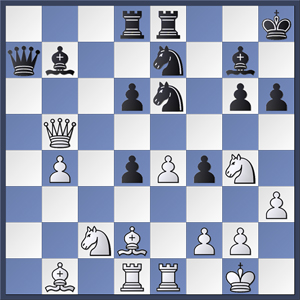
After 30...Nc6 followed by h5 and getting the knight to e5 Black has an active game and somewhat better chances. However, an inexplicable self-pin followed.
30... Ba6?! 31.Qa4 h5 32.Nh2 Qb7 33.Na3 Rb8? 34.Ba2 Nc6
Black’s things are already bad, but after this move he loses a piece.
35.Bd5...
In the forthcoming game Black made a draw without a piece.
By the way, in my opinion, a crushing defeat of Ushenina in the crown match with Hou Yifan at the time was due to such an instability and blunders of Anna, not some lack of understanding of the game.
I am amazed by the number of upsets in the games between masters and grandmasters.
M. Illingworth – S. Movsesian
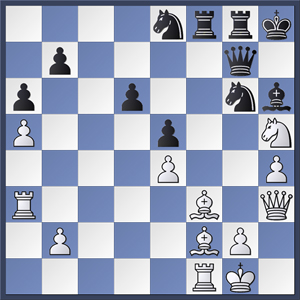
Once again Sergei checks the margin of safety in a chess game, and again goes unscathed. After 40.Nf5 Qh7 41.Kh1 Nf4 42.Qh2 d5 43.Nxh6 Qxh6 44.exd5 (44.Bc5 Rf7 45.exd5 Rfg7 46.Re3) 44...Nf6 45.Bg3 Black is in trouble, but the text move 40.Nh5 is also not bad.
40...Qe7 41.g4 Bd2
Perhaps more persistent is 41...Ng7, getting the f4-square for the knight.
42.g5 Ng7 43.Qg4 Nf4 44.Ng3?!
Simplification is a cornerstone of converting. After 44.Nxf4 Rxf4 45.Qh3 Black would hardly manage to escape.
44...Nge6 45.Bd1 Qh7 46.Nf5 d5, «and all twirled...» Draw was agreed on the 70th move.
R. Mamedov – A. Greet
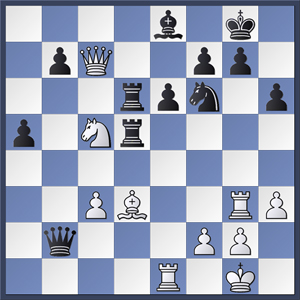
After the self-suggesting 30...Qb6 31.Qe7 Qd8 White can only resign. It is a little more difficult to find 30...Rc6 31.Qe7 Rdxc5 32.Qxf6 Qxc3, and a check on h7 makes no sense, while taking on g7 with a rook is just one check.
The game was eventually won by White.
D. Dvirnyy – D. Van Den Heever
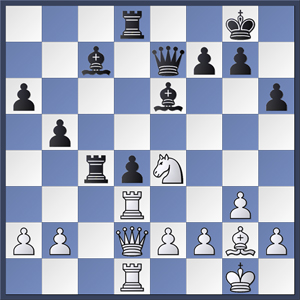
It is difficult to say what kept Black from the primitive 26...f5, maybe the simplicity of the move. After 27.Nc3 dxc3 28.Rxd8+ Bxd8 29.Qxd8+ Qxd8 30.Rxd8+ Kf7 31.bxc3 Rxc3 32.Bb7 a5 33.Rd2 b4 White would hardly save this endgame.
However, 26....Bf5? followed, and after 27.b3 White quite rightly started playing for a win.
A. Milovic – N. Dzagnidze
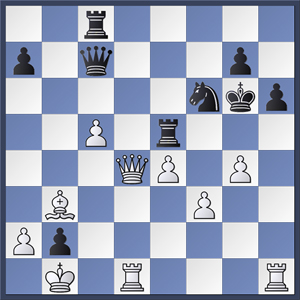
White just needed to make two primitive attacking moves: 31.f4 Rxc5 32.e5, and after 32...Rc1+ (or 32...Rd5 33.Qxb2) 33.Kxb2 Rc2+ 34.Kb1 she could take home a pleasant longtime memory about a victory over one of the best players of the world. However, 31.Qd6 followed, and at the end of it White even lost.
As a rule, overestimating own abilities is better than underestimating, however, local costs may be painful.
R. Rapport – H-A. Rohl Montes
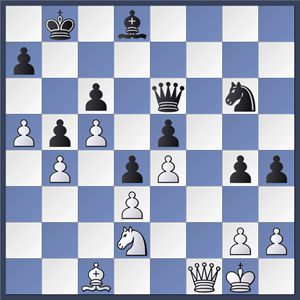
Being 300 rating points ahead does not always mean that the position is ready for a breakthrough. Instead of the measured 39.g3, on which for example 39...Bg5 is possible, the game went on with 39.Qf5??, and after 39...Qxf5 40.exf5 Nf4 Black won a pawn, and furthermore a game.
The third round saw several critical matches between the teams competing for prizes or just high places.
French team won a crucial match against Armenia. As often happens, Sergei Movsesian got not a very good position after the opening and, what is rarely the case in his games, was unable to get out. Fressinet made a good use of his dark-squared bishop that had no counterpart.
S. Movsesian – L. Fressinet
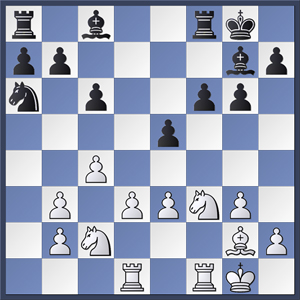
16...Bf5!
An important move that creates temporary dissonance in White’s position. One should react on the bishop because of Na6-c5 threat.
17.Nh4 Bg4 18.Bf3 Bh3 19.Bg2 Bg4 20.Bf3 Be6 21.d4 Rfd8
Black's choice of a rook was correct, which becomes clear from the following white rook maneuver. Black is not afraid of exchanging on e5, because the white knight never gets to e4.
22.Ra1 Nc7 23.Ra5 a6 24.Bg2 Rd7 25.Nf3 Rf8
25...Bf5 is also strong.
26.Nfe1 exd4 27.exd4 f5 28.Nf3 Rd6
The immediate 28...f4 is also not bad. It seems Black is giving a lesson on classical “do not hurry” principle.
29.Ne5 Bc8 30.Re1 f4 31.gxf4 Ne6 32.c5
The f5-f4 idea works good after 32.d5 Nxf4, and there is no capture on c6 because of the rook coming to d2.
32...Rdd8, and White’s position collapsed, Black won a pawn and converted his advantage.
Losing with White is a serious trouble in a match of two teams, but everything could work out fine, if...
L. Aronian – M. Vachier-Lagrave
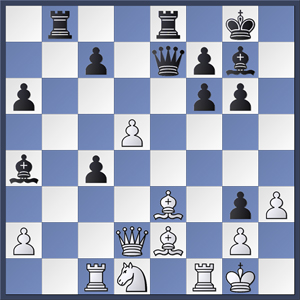
The opening went well for Levon: he managed to win a piece without significant compensation. It is quite hard to say what Aronian disliked about the primitive defensive 22.Rf3+ followed by Bxc4 with a winning position, and why it was necessary to solve the pin problem in such a creative way. In any case, Levon continued with a mistake.
22.Bf4? g5
White's decision is strange also because after 22...Qxe2 23.Qxe2 Rxe2 24.Nc3 Rbb2 25.Nxe2 Rxe2 26.Rxc4 Rxa2 27.Rxc7 Bc2 his advantage is not big.
23.Bxg3 Qxe2 24.Qxe2 Rxe2 25.Nc3 Re3 26.Bxc7
It was possible to take the exchange, but after 26.Bf2 Rxc3 27.Rxc3 and now, for example, 27...Rb2 Black has all the reasons to count on the pleasant outcome. That is why Levon tries to use the strength of the passed pawn, but there is no serious danger for Black.
26...Rb7 27.Nxa4 Rxc7 28.d6 Rd7 29.Nb6 Rd8 30.Rxc4 Re6 31.d7 f5
Of course not 31...Rxb6?? 32.Rc8 Rb8 33.Rxb8 Rxb8 34.Rc1.
32.Rb1 Rd6 33.Kf1 Bd4 34.Rd1 Rxb6 35.Rdxd4 Kf8 36.Rc5 f6 37.Rxf5 Ke7 38.Rfd5 Rb7 39.Ra4 Rdxd7 40.Rxd7+ Rxd7 41.Rxa6
With the last moves Black managed to save the material balance, but Vachier-Lagrave chooses the easiest solution, rightly estimating that the arisen endgame with a rook behind the pawn is a draw with an elementary technique. Soon the players agreed to a draw.
The Chinese team conducted a victory of a similar importance over the Hungarian national team, but during the course of the match the result could be the opposite.
P. Leko – Wang Yue
1.e4 e5 2.Nf3 Nf6 3.Nxe5 d6 4.Nf3 Nxe4 5.Nc3 Nxc3 6.dxc3 Be7 7.Be3 Nc6 8.Qd2 Be6 9.0–0–0 Qd7 10.h4 h6 11.b3!?
An interesting opening nuance, although it is quite typical in different variations. White tries to capitalize on something comparing with 11.Kb1 Bf6 12.Nd4.
11...Bf6 12.Nd4 a6
Of course one should also check exchanges: 12...Nxd4 13.Bxd4 Bxd4 14.Qxd4 0–0, and now, for example, 15.Rd3.
13.Nxe6 fxe6 14.g3 0–0–0 15.Bh3 Kb8 16.Rhe1 Rde8 17.Bg2 d5 18.Bc5 g5 19.hxg5 hxg5 20.Qe3 Qg7
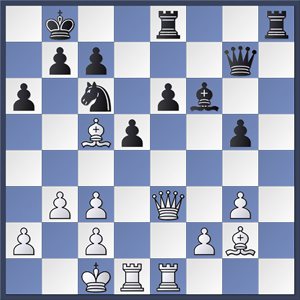
It transpires that White’s11th move also had some drawbacks. However, Leko uses the opportunity to conduct a small combination.
21.Bxd5! exd5?!
Black goes for it for no good. In order to find the strongest 21...Bxc3! one had to find that 22.Bxc6 is met with a nice trick: 22...Rd8! (Bd2+ is a threat) 23.Bd7 (23.Bd5 Bd2+! 24.Kxd2 Rxd5+) 23...Bxe1 24.Bd4 Bxf2 25.Qxf2 e5 26.Ba7+ Ka8 27.Bg4 Rxd1+ 28.Bxd1 Rf8 29.Qe3 b6, winning one of the bishops with approximate equality.
22.Qxe8+ Rxe8 23.Rxe8+ Bd8 24.Rxd5 Kc8 25.Be7 Qxe7 26.Rxe7 Bxe7 27.Kd2
The arisen ending is in White’s favor. Black did not manage to hold.
Ding Liren – C. Balogh
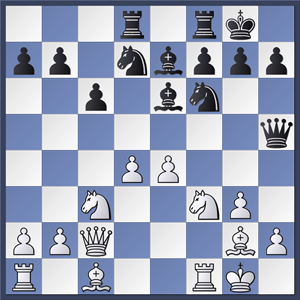
It is obvious that Black misplayed in the opening, but the game is aesthetically valuable thanks to the beautiful maneuvers of white knights. I suggest to follow them since this moment.
15.Ne2 Qb5 16.Nf4 Qc4 17.Qb1 Bg4 18.b3 Qb4 19.Bb2 Rfe8 20.Qc2 Qb6 21.Kh1 Nh5 22.Nd3 Nhf6 23.Nd2
23.Ng5 leads to an almost decisive advantage: 23...h6 24.Nxf7 Kxf7 25.h3!, but it is not yet the right time to screw the painting.
23...Nf8 24.Nc4 Qc7 25.Ne3 Qc8 26.Qf2 Bh5 27.Nf4 Ng4 28.Nxg4 Bxg4 29.d5 f6 30.h3 Bd7 31.e5, and Black’s position is hopeless. Soon White won.
Z. Almasi – Yu Yangyi
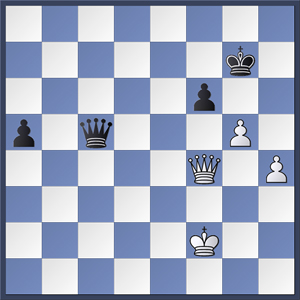
The queen endgame is equal for the last 40 moves, and Black’s biggest achievement of the last 30 moves is that White pushed him pawn from g3 to g5. Suddenly Zoltan loses concentration for a second – 81.Ke2?? – and it’s over, his team loses the match.
81...Qe5+! 82.Qe3 Qxe3+ 83.Kxe3 f5 84.h5 a4 85.Kf4 a3 White resigs.
A bit unexpected, as it seems to me, but quite deserved was a victory of Holland over USA.
E. L’Ami – G. Kamsky
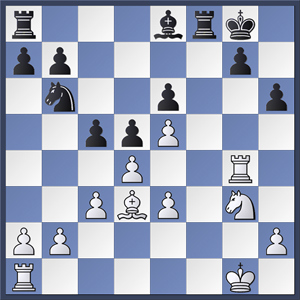
Kamsky was not accurate in the opening. Black’s position is worse due to a bad bishop and a weak e6-pawn.
20...Rc8
20...Na4 gives nothing, 21.Rb1 Rf3 22.Bc2.
21.Rf4 cxd4 22.cxd4 Rf7
If White manages to make all necessary prophylactic moves, Black’s position would become totally passive. This is why looking into quite drastic continuations like 22...g5 23.Rxf8+ Kxf8 24.Rf1+ Kg7 is perfectly sensible. Black plans to cover f6 with the knight and bring the bishop to g6. It is important that the control over the c-file is on his side. After the exemplary 25.Be2 Bf7 26.Nh5+ Kf8 27.Rf6 Rc1+ 28.Kf2 Rc2 Black is fine.
23.b3 Nd7 24.h4 Nf8 25.Kf2 Rfc7
It seems Black has a concrete solution that let him escape the unpleasant situation: 25...Rxf4+!? 26.exf4 Ng6 27.f5 Nf4 (possible is 27...Nxh4 28.fxe6 g5) 28.Rd1 (28.Bf1 Rc3) 28...Rc3 29.Ke3 g5 30.fxg6 Bxg6 31.Kxf4 Bxd3=. Deviating from drastic but necessary actions, Black soon finds himself fully pressed against the ropes.
26.Ke2 Rc1 27.Rf1 Rxa1 28.Rxa1 Bg6 29.Rf1 Be8 30.Kd2 Rc7 31.Ne2 Ng6 32.h5 Nf8 33.Nf4 Bc6 34.Rc1 Kf7 35.b4 Rc8 36.b5 Bd7 37.Rf1 Ke7 38.a4 b6 39.Ra1 Rc7 40.a5 bxa5 41.Rxa5
Using Kamsky’s time trouble, White implemented a model plan to restrict the mobility of the black pieces. Finishing him was unhurried, but inevitable.
R. Van Kampen – V. Akobian

Until this moment White’s advantage did not exceed the symbolic level, and finally Black got a chance for a forced draw: 38...Qg1! 39.Bxh6+ Ng7 (there is no choice because of the Bc8+ threat) 40.Bxg7+ Kxg7 41.Qh7+ Kf8 42.Be4 Bc8+ 43.Bf5 Bb7=. At this very moment Black's true troubles started. First he misses a profitable opportunity with 38....h5, then seriously spoils his position with the control move.
39.d5 Nc5 40.Qd4 f6?
After 40...a4 the position can be considered equal. Nothing scary has yet happened, but in the forthcoming game, solving small problems for 20 more moves, Black transposed to a lost pawn endgame.
2665-rated player’s attitude towards an open file in the next game made a strong impression on me.
G. Jones – G. Meier
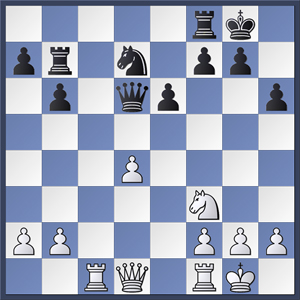
White played the opening without much ambition, and it's time to carefully secure a draw. The position is more than standard. What might one think about, if not of the only open file on the board? In this regard 18.Re1!? with the idea of doubling with Re2-c2 deserves attention, and taking the opportunity 18...Rc7 19.Rxc7 Qxc7 20.d5! or 18.Qd2, so that after a possible exchange he can put the second rook on the c-file. However, the game continued differently.
18.Qc2 Nf6 19.Qc6 Qe7 20.Qb5 Rc7 21.Qa6
It is still not late to play 21.Rc4, keeping the file and probably trading all the rooks.
21...Qd7 22.Rxc7 Qxc7
Comparing this position with the one on the diagram above needs no comments. In the end Black converted his small advantage.
Sadler managed to level the match beating Baramidze, and the tense match ended in a draw.
The match between the closely rated teams of Cuba and Poland appeared to be persistent and fighting. All the games ended in draws, with Bartosz Socko almost bringing his team a decisive point.
I. Ortiz Suarez – B. Socko
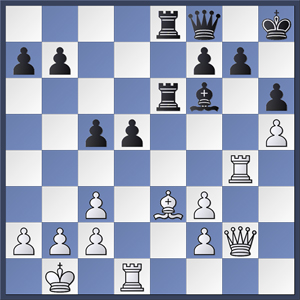
As it sometimes happens in this line, White got overexcited and is left with weaknesses and an unpleasant position. Right now Black can get a decisive advantage: 25...d4! 26.cxd4 cxd4, and White has to give up an exchange because the bishop’s retreats lead to a catastrophe on the queenside: 27.Bd2 (27.Bc1 Qc5; 27.Bxd4 Re1 28.Rc1 Qb4 with a win) 27...Rb6! with a winning attack. Socko, however, slowed down.
25...Re5? 26.Qh1
26.f4 does not promise complete equality, 26...Rxh5 27.Rxd5 Rxd5 28.Qxd5 Rd8 29.Qf3 Qd6.
26...Rd8 27.Ra4 Qe8 28.Rxa7 d4 29.cxd4
For the second time Black did not miss the opportunity for a breakthrough. The intermediate 29.f4!? is tempting but does not help because of 29...dxe3! 30.Rxd8 Qxd8 31.fxe5 e2 32.Ra8 Qxa8 33.exf6 Qd8 34.Kc1 Qd6, and the passed pawn on e2 should decide the game.
29...cxd4 30.Bc1 Re2 31.f4 d3?
Unnecessary spectacular opening of the diagonal. He could just attack the core pawn and take it: 31...Rc8! Pressure on the с-file and perspectives of marching with the d-pawn decide the game: 32.Qf3 (or 32.Rxb7 Rexc2 – with a threat of Qe2, d3 - 33.Qf3 Qe6, winning due to the threats of Rxc1 and Qc4) 32...Rexc2 33.Ra3 Qe6 with a win.
32.Rxd3 Rxd3 33.cxd3 Qb5 34.Rxb7 Qxd3+ 35.Ka1 Rxf2
35...Qc2 36.a3 gives nothing.
36.Rb8+ Kh7 37.Qa8 Bxb2+ 38.Rxb2 Qc4 39.Rb1 Qd4+ 40.Bb2 Rxb2 41.Rxb2 Draw.
Among the spectacular victories of the round ione should note Topalov’s win over Vallejo, achieved with a queen sacrifice that always touches hearts.
V. Topalov – F. Vallejo Pons
1.d4 f5 2.c4 Nf6 3.Nc3 e6 4.a3 g6 5.Bf4 Bg7 6.e3 0–0 7.Nf3 d6 8.Be2 h6
Calm development of Black gives White a serious advantage. Perhaps it was worth to concentrate on carrying out the e6-e5 as soon as possible.
9.h3 g5 10.Bh2 Nbd7 11.Qc2 b6 12.Rd1 Kh8 13.b4 Bb7 14.d5!
A precise move, as White does not allow simplifications that are profitable for Black: 14.0–0 Ne4.
14...e5 15.Nd2 c6
Black recklessly creates new weaknesses, trying to improve the position of the bishop. It is more expedient to seek classical King's Indian counterplay on the kingside: 15...Qe8 16.0–0 g4.
16.dxc6 Bxc6 17.0–0 Rc8 18.Qxf5!
Such a queen sacrifice that turns black pawn structure in a sieve is of course obvious but yet a queen is a queen.
18...Ne4 19.Qxf8+ Bxf8 20.Ndxe4± Qc7 21.Rd2 Kg7 22.Rfd1 Nf6 23.Nxd6 Bxd6 24.Rxd6 Qe7 25.Bg3
My initial enthusiasm for White's idea of converting the advantage somewhat subsided when I realized the goal could be reached in a more primitive way. White crushes after 25.c5 bxc5 26.b5 Be8 (26...Ba8 27.Bg4) 27.Ra6 Rb8 28.Rdd6, as well as after 25.Bg4 Nxg4 26.hxg4 Rc7 27.c5 bxc5 28.bxc5 Kh7 29.Bg3 Qe8 30.Nd5.
25...Be8 26.Rxf6!? Qxf6
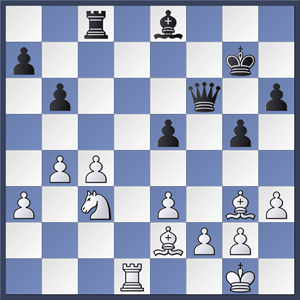
After all, you don’t see it every day – getting two minor pieces with pawns for a queen as one of the steps of converting the advantage.
27.Ne4 Qg6 28.Nd6 Ba4
A little more persistent is 28...Ra8 29.Bxe5+ Kf8 30.Rd4, but Black fails to coordinate his pieces, so White should win.
29.Rd5 Qb1+ 30.Kh2 Rf8 31.c5 Bb3 32.Rxe5 Qc2 33.Bf3 Rxf3 34.gxf3 bxc5 35.bxc5 Ba4 36.Nf5+ Kg6 37.c6 h5 38.Nd4 Qc4 39.h4 gxh4 40.Bxh4 a5 41.Re6+ Kf7 42.Re7+ Kg6 43.c7 Black resigns.
The Russian team enjoyed the benefits of being luckily seeded in the tournament grid due to its high average rating and easily won against Macedonia.
T. Nedev – V. Kramnik
1.e4 e5 2.Nf3 Nc6 3.d4 exd4 4.Nxd4 Nf6 5.Nxc6 bxc6 6.e5 Qe7 7.Qe2 Nd5 8.c4 Ba6 9.b3 g6 10.f4 d6 11.Qf2 Nf6 12.Be2 dxe5 13.0–0 Ne4 14.Qf3 f5 15.Nc3 exf4 16.Nxe4 fxe4 17.Qxf4 Bg7 18.Ba3 Bd4+ 19.Kh1 c5 20.Rae1 Rf8 21.Qg4 Bc8
The whole variation, including the last move, was played quite quickly by Vladimir. According to the time-study on the site, significant amount of time was spent only for the natural 15...eхf4 – perhaps, he was trying to recall it. Besides the retreat of the bishop (after which White had an opportunity to keep the balance), a little risky 21...Rd8!? deserved attention, as well as the preliminary trade on f1, if White takes with the rook. If 21...Rxf1 22.Bxf1 Bb7 22.Bd3, then 22...Kf8! 23.Be4 Kg7!, and the weakness of the back rank promises Black an advantage in the variations.
22.Rxf8+ Kxf8 23.Qf4+ Kg8 24.Rd1
Of course not 24.Bf3 Bb7 25.Be4 because of 25...Rf8.
24...g5
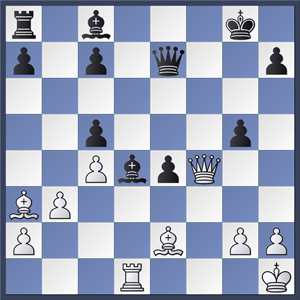
25.Qg3?!
Inaccuracy. 25.Qd2! leads to a forced draw: 25...Qe5 26.Bb2! Bxb2 (or 26...Bb7 27.Bxd4 cxd4 28.Qxd4 Qxd4 29.Rxd4 Rf8 30.Kg1 e3 31.Bf1 Re8 32.Be2 Rf8 also with a draw) 27.Qd8+ Kg7 28.Rd5 Qf6 29.Rxg5+ Kh6 30.Rh5+ Kg7, and a draw with perpetual.
25...Qg7 26.b4?
This is a serious mistake, after which White’s position is already hard. The correct 26.Bc1 h6 27.h4 Bb7 28.hxg5 hxg5 29.Bxg5 Rf8 30.Bg4 e3 31.Re1 still keeps the balance, despite the obvious danger of such course of the game.
26...Be6 27.bxc5 Rb8 28.h3 Qe5 29.Qxe5 Bxe5 30.c6 Rb6 31.c5 Rb8 32.Bc1 Bxa2 33.Bxg5 a5 34.Be7 Bb3 35.Rf1 a4 White resigns.
The match of the women’s team, on the other hand, almost turned to a thriller.
K. Lagno – M. Sebag
1.e4 c5 2.Nf3 d6 3.Bb5+ Nd7 4.d4 cxd4 5.Qxd4 a6 6.Bxd7+ Bxd7 7.c4 Bg4
A rare move. The bishop would be most likely misplaced here, and White tries to demonstrate it with her reply.
8.Nfd2!? Nf6 9.Nc3 e6 10.h3
Perhaps White did not need this move. It is possible to underline the drawbacks of the bishop’s location with a simple knight maneuver to e3 with a tempo.
10...Bh5 11.b3
Immediate attack with pawns is met with a pawn sac:11.f4 e5 12.fxe5 dxe5 13.Qxe5+ Qe7!? 14.Qxe7+ Bxe7 with good compensation.
11...Be7 12.Bb2 Qc7 13.Rc1 Rd8 14.Nf1 0–0 15.g4?!
Preventing Black's break by 15.Ne3!? deserved attention. Black's light-squared bishop becomes somewhat misplaced in this case. White tries to exclude the bishop by more standard measures, but she forgets that this is not the Ruy Lopez.
15...Bg6 16.Ng3 d5! 17.cxd5 Bc5 18.Qd2 exd5?
After getting an advantage with a central breakthrough, Black immediately commits a serious mistake. After the correct 18...Qd6! it is not easy for White to find the right way. Still, after 19.Kf1! exd5 20.e5! Qxe5 21.Na4 Ne4 22.Be5 Nd2 23.Kg2 White, despite the loss of a pawn, keeps decent chances for a draw.
19.Nxd5?
White misses 19.Na4! b6 20.Nxc5 bxc5 21.Bxf6 gxf6 22.Qh6, and the advantage can be only at her side.
19...Nxd5 20.exd5 Qd6 21.Rd1
A cute option is left behind the scenes: 21.Bxg7 Be3! 22.Qxe3 Rfe8 23.Bd4 Rxe3+ 24.Bxe3 Re8.
21...f5
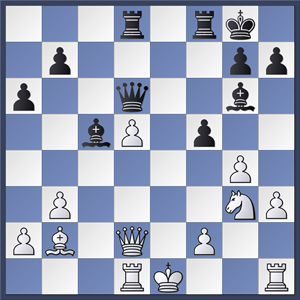
An exchange of mistakes only worsened White’s position, which was not sugar anyway. The position on the diagram is worse than it looks, and it looks hopeless.
22.gxf5 Bxf5 23.Qg5
After 23.Bd4 Black wins, for example, this way: 23...Rfe8+ 24.Kf1 Qxd5 25.Bxc5 Qxd2 26.Rxd2 Rxd2 27.Nxf5 Re5 28.Ne7+ Kf7.
23...Rde8+ 24.Kf1 Bg6
Any of the checks elementary crushes White’s position: 24...Bd3+, 24...Bxh3+.
25.Bd4 Bxd4
Series of quite natural moves turned White’s army into just a set of pieces that were accidentally thrown on the board: 25...h6 26.Qg4 Bxd4 27.Rxd4 Qf6 28.Rh2 (28.Rd2 Qc3) 28...h5! 29.Qd1 h4 30.Nh1 Be4.
26.Rxd4 Re5
Black totally lost the thread and aims his blow in a completely wrong direction. After 26...h6 27.Qh4 Qc5 28.Kg2 Be4+! White only had to resign.
27.Qd2 Rd8 28.Kg2 Rxd5 29.Rxd5 Qxd5+ 30.Qxd5+ Rxd5 31.Rc1 Draw.
Black’s position is still a little better, but after so many missed opportunities agreeing to a draw would seem a reasonable decision to anyone.
S. Milliet – V. Gunina
1.e4 c6 2.d4 d5 3.Nc3 dxe4 4.Nxe4 Bf5 5.Ng3 Bg6 6.Nh3 e6 7.Bc4 Bd6 8.0–0 Nf6 9.f4 Qc7 10.Kh1 Nbd7?!
It is quite difficult to explain what prevented Black from castling.
11.f5 exf5 12.Qe2+ Kd8?!
After 12...Kf8 it is all not that scary, but now things take a dark course.
13.Nxf5 Bxh2 14.Bxf7!
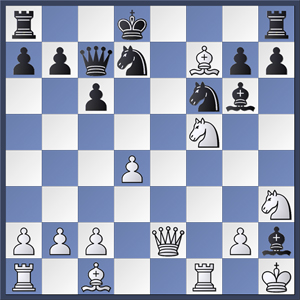
It seems the game won’t last, and amazingly it appears so.
14...Bxf5 15.Rxf5 g6 16.Rxf6?!
White’s position is completely winning, but unfortunately for her there is no straightforward way to gain material, however difficult is to believe in it. So White should simply make several calm moves: 16.Ng5 Kc8 17.Rf3 with further development of queenside bishop and rook.
16...Nxf6 17.Qe6 Nd7 18.Bg5+ Kc8 19.Bf6 Rf8 20.Be7 Rh8 21.Bf6
After the self-suggesting 21.Ng5, despite an extra exchange Black’s position is still hopeless. However, White is obviously too disappointed with her own inability to find the illusory easy win and just folds the game.
21...Rf8 22.Be7 Rh8 Draw.



















